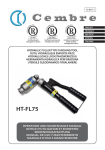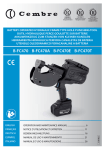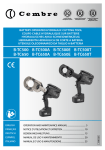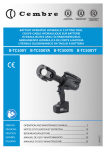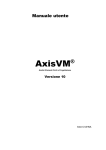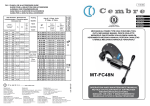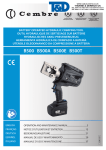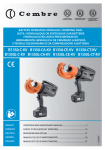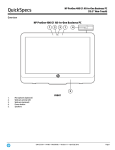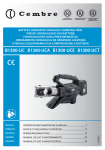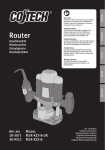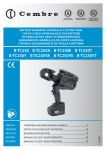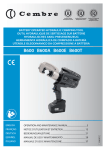Download Manuale d`uso e manutenzione
Transcript
Certified Quality Management System Certified Environmental Management System Certified Occupational Health & Safety Management System BATTERY OPERATED HYDRAULIC PULLER TYPE PUNCHING TOOL OUTIL HYDRAULIQUE EMPORTE-PIECE SUR BATTERIE HYDRAULISCHES AKKU-LOCHSTANZWERKZEUG HERRAMIENTA HIDRÁULICA PERFORADORA A BATERíA UTENSILE OLEODINAMICO FORALAMIERE A BATTERIA ENGLISH OPERATION AND MAINTENANCE MANUAL ................................... 6 FRANÇAIS NOTICE D’UTILISATION ET ENTRETIEN ........................................... 11 DEUTSCH BEDIENUNGSANLEITUNG ................................................................... 16 ESPAÑOL MANUAL DE USO Y MANTENIMIENTO ........................................... 21 ITALIANO MANUALE D’USO E MANUTENZIONE............................................. 26 1 14 M 079 B-FL750 B-FL750A B-FL750E B-FL750T FIG. / BILD 1 2 4 4 Locking ring - Virole - Kontermutter - Contera - Ghiera Punch - Poinçon - Stempel - Punzón - Punzone Pilot hole Avant-trou Pilotbohrung Agujero piloto Preforo pilota 3 4 2 B-FL750 Draw Stud - Tirant Zugbolzen - Tirante Die - Matrice - Matrize Matriz - Matrice 3 Die - Matrice - Matrize Matriz - Matrice Draw Stud - Tirant Zugbolzen - Tirante 40 3 1 Draw Stud - Tirant Zugbolzen - Tirante FIG. / BILD 2 1 10 2 3 4 5 9 6 8 7 1+3 LED WORKLIGHT / ECLAIRAGE PAR LED / LED ARBEITSLICHT / LUCES LED / ILLUMINAZIONE LED 2 HEAD / TETE / KOPF / CABEZA / TESTA 4 OPERATING BUTTON / GACHETTE DE COMMANDE / STARTKNOPF / BOTÓN DE ACCIONAMIENTO / PULSANTE DI AZIONAMENTO 5 PRESSURE RELEASE BUTTON / GACHETTE DE DECOMPRESSION / DRUCKABLASSKNOPF / BOTÓN DESBLOQUEO PRESIÓN / PULSANTE DI RILASCIO 6 BATTERY / BATTERIE / AKKU / BATERÍA / BATTERIA 7 BATTERY CAPACITY INDICATOR / INDICATEUR DE CHARGE / AKKUANZEIGE / INDICADOR DE CARGA BATERIA / INDICATORI AUTONOMIA BATTERIA 8 BATTERY CHECK BUTTON / BOUTON POUR CONTROL DE LA BATTERIE / TASTE FÜR AKKUÜBERPRÜFUNG / BOTÓN DE CONTROL BATERÍA / PULSANTE DI VERIFICA BATTERIA 9 BATTERY RELEASE / DEBLOCAGE BATTERIE / AKKU ENTRIEGELUNG / DESBLOQUEO BATERÍA / SBLOCCO BATTERIA 10 RING FOR SHOULDER STRAP / ANNEAU POUR BANDOULIERE / TRAGERIEMENRING / ANILLO PARA CORREA / ANELLO AGGANCIO TRACOLLA 3 Die - Matrice Matrize - Matriz Matrice Punch - Poinçon Stempel - Punzón Punzone OK Draw Stud - Tirant Zugbolzen - Tirante 4 NO NON NEIN FIG. / BILD 3 Waste slug Copeau de perçage Stanzabfall Virutas de perforación Sfrido di tranciatura 5 FIG. / BILD 4 4 WARNING SYMBOLS - SYMBOLES D'AVERTISSEMENT - WARNSYMBOLE SÍMBOLOS DE ADVERTENCIA - SIMBOLI DI AVVERTENZA Tool - Outil - Werkzeug - Herramienta - Utensile – Before using the tool, carefully read the instructions in this manual. – Avant d'utiliser cet outil, lire attentivement les instructions de cette notice. – Vor Inbetriebnahme unbedingt die Bedienungsanleitung durchlesen. – Antes de utilizar la herramienta, leer atentamente las instrucciones en este manual. – Prima di utilizzare l'utensile, leggere attentamente le istruzioni riportate in questo manuale. TG.0960 – When operating the tool, keep hands away from the danger zone. – Au cours de l'utilisation, tenir les mains éloignées de la zone de danger. – Während der Arbeit nicht mit den Händen in den Gefahrenbereich fassen. – Durante su utilización, mantenga las manos fuera de la zona de peligro. – Durante l'utilizzo, mantenere le mani fuori dalla zona di pericolo. – Always wear safety glasses and gloves when operating this tool. – Porter toujours les lunettes de protection et les gants de travail. – Immer mit Schutzbrille und Handschuhen bedienen. – Trabajar siempre con las gafas y guantes de seguridad. – Operare sempre con occhiali di protezione e guanti da lavoro. – User information (Directives 2002/95/EC and 2002/96/EC), see page 34. – Information pour les utilisateurs (Directives 2002/95/CE et 2002/96/CE) voir page 34. – Information für den Benutzer (Richtlinien 2002/95/EG und 2002/96/EG) siehe Seite 34. – Informe para los usuarios (Directivas 2002/95/CE y 2002/96/CE) vease página 34. – Informazione agli utenti (Direttive 2002/95/CE e 2002/96/CE) vedere pagina 34. Battery -Batterie - Akku - Batería - Batteria – Never throw batteries into fire or water. – Jamais jeter les batteries dans le feu ou dans l'eau. – Werfen Sie Akkus nicht in das Feuer oder Wasser. – Nunca tire las baterías al fuego o al agua – Mai gettare le batterie nel fuoco o in acqua. – Always recycle the batteries. – Recycler toujours les batteries. – Verbrauchte Akkus stets dem Recycling zuführen. – Reutilizar siempre las baterías. – Riciclare sempre le batterie. – Do not discard batteries into domestic refuse or waste disposal. – Ne pas jeter de batteries dans une poubelle ou autre lieu non prévu à cet effet. – Verbrauchte Akkus nicht in den Hausmüll werfen. – No tirar las baterías al cubo de basura o lugar parecido. – Non buttate le batterie fuori uso nei cestini della spazzatura o luoghi simili. 5 ENGLISH 1. GENERAL CHARACTERISTICS B-FL750 Application range Max. punching capacity Dimensions (ref. to Fig. 5) Weight with battery Motor Operating temperature B-FL750T B-FL750A suitable for punching single layers of Stainless Steel, Mild Steel, Fibreglass, Plastic material ø 140 / 5.5 mm (inches) Developed force Minimum operating pressure B-FL750E 75 (9) bar (psi) 700 (10,000) mm (inches) 363 x 366 x 83 (14.3 x 14.4 x 3.3) kg (lbs) 5,1 (11.2) V DC 18 °C (°F) -15 to +50 (+5 to +122) Recommended oil AGIP ARNICA 32 or equivalents Operating speed twin speed operation and automatic switching from a rapid advancing speed of the ram to a slower, more powerful speed Safety Rechargeable battery maximum pressure valve V / Ah / Wh 18 / 4.0 / 72 Type Weight Battery charger CB1840L (Li-Ion) kg (lbs) type ASC30-36 0,66 (1.45) EU 27044000 UK 27045000 AUS/NZ 27047000 V / Hz 220 - 240 / 50 - 60 W 85 Acoustic noise (1) LpA dB (A) 73 LpCPeak dB (C) 94.5 LWA dB (A) 79 m/s2 0.575 max. Input Vibration (2) USA/CAN 27046000 115 / 60 (1) Directive 2006/42/EC, annexe 1, point 1.7.4.2 letter u) LpA = weighted continuous acoustic pressure level equivalent. LpCPeak = maximum value of the weighted acoustic displacement pressure at the work place. LWA = acoustic power level emitted by the machine. (2) (Directive 2006/42/EC, annexe 1, point 2.2.1.1) Weighted root mean square in frequency of the acceleration the upper limbs are exposed to for each biodynamic reference axis. Tests carried out in compliance with the indications contained in UNI ENV 25349 and UNI EN 28662 part 1st Standards, and under operating conditions much more severe than those normally found. 6 Do not use the tool for purposes other than those intended by Cembre. The operator should concentrate on the work being performed and be careful to maintain a balanced working position. Before each use check the punches, dies and draw studs, and replace any that are worn or damaged, particularly any punches that have damaged cutting surfaces. Damaged or improperly assembled accessories can break and hit the operator with sufficient force to cause serious injuries. Before each use, verify the integrity of the tool; replace any worn, possibly damaged or missing parts with original Cembre spares. Only for use in punching holes in single layers of material and thicknesses as shown in TABLES 1 and 2. Any other use may cause components to break with potential risk of serious injury. During operation do not allow anyone to pause in the work area, especially in front of the punch. The use of Cembre punching accessories is recommended. Accessories from other suppliers may not be designed to withstand the force generated by this tool and may be damaged or break with potential risk of serious injury. Protect the tool from rain and moisture. Water will damage the tool and battery. Electro-hydraulic tools should not be operated in pouring rain. 2. INSTRUCTIONS FOR USE The part reference includes the following (Ref. to Fig. 6 page 31): A - Hydraulic tool. B - Li-Ion rechargeable battery (2 pcs). C - Battery charger (model depends on the tool version). D - Shoulder strap. E - Carrying case. F - ø 11.5 mm Spiral bit (code 6134070). TD-11 Draw stud with threaded 7/16"-3/4" (code 2685005). TD-19 Draw stud with threaded 3/4"-3/4" (code 2685008). 2.1) Preparation The tool can be easily carried using either the handle or the shoulder strap attached to ring (10) (Ref. to Fig. 2). Before starting any work, check the battery charge (Ref. to § 2.7) and recharge if necessary, following the instructions in the battery charger user manual. 9 To replace the battery, remove it by pressing the release button (9), then insert the new battery, sliding it into the guides until it locks. 7 Battery ENGLISH WARNING ENGLISH 2.2) Head rotation Two independent joints enable the tool head to turn through 360° and rotate through 180°, allowing the operator to work in the most comfortable position. Do not attempt to turn the head when the hydraulic circuit is pressurised. 2.3) Assembling of the accessories (Ref. to Fig. 1) Consult the tables on pages 32 and 33 and select the RD... Punching Kit suitable for the hole to be made. For punching requirements other than those listed, please contact Cembre. 1 2 3 4 Round holes ø 15.5 to 30.5 mm Drill a pilot hole in the plate at the desired point, using the ø 11.5 mm spiral bit supplied with the tool. Fully screw the TD-11 draw stud into the ram (40). Thread the die onto the draw stud, pushing it to rest on the head. Insert the draw stud into the pilot hole and screw the punch onto the draw stud until its cutting edges are touching the back of the layer of material being punched. Round holes ø 28.5 to 80.5 mm 1 Drill a pilot hole in the plate at the desired point, using a ø 20 mm spiral bit; alternatively, it is possible to make the pilot hole with the ø 11.5 mm spiral bit supplied with the tool and widen it with the KIT RD20.5SS. 2 Fully screw the TD-19 draw stud into the ram (40). TD-19 draw stud is threaded 3/4" at both ends, screw the short thread into the ram. 3 Thread the die onto the draw stud, pushing it to rest on the head and continue as described in point 4 above. Round holes ø 100 to 120 mm 1 Drill a pilot hole in the plate at the desired point, using a ø 29 mm spiral bit; alternatively, it is possible to make the pilot hole with the ø 11.5 mm spiral bit supplied with the tool and widen it with the KIT RD30.5SS. 2 Thread the die onto the TD-28.5 draw stud (supplied with the Punching Kit) before screwing it into the ram. 3 Fully screw the draw stud into the ram (40) and continue as described in point 4 above. 1 2 3 4 Square and rectangular holes With a drill make the required pilot hole (see Tab. 2) in the plate at the desired point. Fully screw the draw stud (supplied with the Punching Kit) into ram (40) of the head. Thread the die into the draw stud, pushing it to rest on the head. Insert the draw stud into the pilot hole, thread the punch onto the draw stud until its cutting edges are touching the back of the layer of material being punched then fully screw the locking ring onto the draw stud to lock the punch in place. 8 Before punching: Check the correct match between die and punch. Check that the draw stud is completely screwed into the ram head. Check that the punch is completely screwed onto the stud, with its cutting edges touching the back of the layer of material being punched. Keep hands away from the punching zone to avoid serious risk of injury! Firmly hold the tool and operate the push-button (4) to achieve the required hole: the ram will gradually pull the punch forward until the hole is produced. When the hole is performed, release the push-button (4), otherwise after the maximum pressure relief valve has activated the motor, and will stop automatically. 2.5) LED Worklights Whilst the tool is in operation, the work area is illuminated by two high luminosity LED Worklights that switch off automatically at the end of the cycle. 2.6) Retracting the punch (Ref. to Fig. 4) Press the pressure release button (5), the ram will back and the punch out of the hole. Remove the punch from the draw stud then carefully and completely remove the scrap slug and any residue from the die. Check and remove scrap slug and any residue from the die. 2.7) Battery status The battery is equipped with LED indicators that indicate the remaining battery life at any time by pressing the adjacent button (7): 4 LEDs illuminated: fully charged 2 LEDs illuminated: 50 % capacity 1 LED flashing : minimum charge, replace the battery. 7 1 Tool LEDs (1and 3) illuminated combined with an alarm audible when the operating button (4) is pressed, indicate that the battery voltage has dropped below a minimum safety threshold; under these conditions the tool will not start, and it is necessary to recharge or replace the battery. The approximate time to fully recharge a battery is about 80 minutes. 3 4 9 ENGLISH 2.4) Punching (Ref. to Fig. 3) ENGLISH After each working cycle, and after the extraction of the battery from the tool, an integrated battery cut-off device will operate after 70 s approx. Then the LED nearest to button (P) will flash 5 times each 14 s approx. The battery will be reactivated when it is reintroduced into the tool and the operating button is pressed. 2.8) Using the battery charger Carefully follow the instructions in the battery charger user manual. 3. MAINTENANCE The tool is robust, completely sealed, and requires very little daily maintenance. Compliance with the following points, should help to maintain its optimum performance: 3.1) Thorough cleaning Dust, sand and dirt are a danger for any hydraulic device. Every day, after use, the tool must be wiped with a clean cloth taking care to remove any residue, especially close to pivots and moveable parts. Do not use hydrocarbons to clean the rubber parts. 3.2) Storage case When not in use, the tool should be stored and transported in the steel case, to prevent damage. The case, type VAL FCL, is suitable for storing the tool and the accessories. VAL FCL: Size 565x410x132 mm (22.2x16.1x5.2 inches), Weight 6,7 kg (14.7 lbs). 4. USE OF NON ORIGINAL Cembre PUNCHING ACCESSORIES To obtain the best operating results, the use of original Cembre punching accessories is recommended; as an alternative, it is possible to use punching accessories made by other manufacturers by requesting separately the specific adaptor (see Table 3). Check the compatibility of the accessories with the characteristics of the B-FL750 tool. 5. RETURN TO Cembre FOR OVERHAUL In the case of a breakdown, contact your local Agent who will advise you on the problem and give you the necessary instructions on how to dispatch the tool to our nearest service Centre; if possible, attach a copy of the Cembre Test Certificate supplied with the tool or, if no other references are available, indicate the approximate purchase date and the tool serial number. 10 1. CARACTERISTIQUES GENERALES B-FL750 B-FL750T B-FL750A conçu pour percer des tôles d’acier inoxydable, l’acier doux, des parois en fibre de verre et la matière plastique. Capacité de percage maxi. mm (inches) ø 140 / 5.5 Force nom. de sertissage kN (USA ton) 75 (9) Pression min. de travail bar (psi) Dimensions (voir Fig. 5) mm (inches) Poids avec batterie Moteur 700 (10,000) 363 x 366 x 83 (14.3 x 14.4 x 3.3) kg (lbs) 5,1 (11.2) V DC Température de fonctionnement: FRANÇAIS Domaine d'application: B-FL750E 18 °C (°F) -15 à +50 (+5 à +122) Huile recommandée: AGIP ARNICA 32 ou équivalents. Avance rapide: l’outil passe automatiquement de la vitesse rapide à la vitesse lente de perçage. Sécurité valve de surpression. Batterie rechargeable V / Ah / Wh 18 / 4.0 / 72 Type CB1840L (LI-Ion) Poids kg (lbs) Chargeur de batterie type ASC30-36 0.66 EU 27044000 UK 27045000 AUS/NZ 27047000 V / Hz 220 - 240 / 50 - 60 W 85 Bruit aérien sonore (1) LpA dB (A) 73 LpCPeak dB (C) 94.5 LWA dB (A) 79 m/s2 0.575 maxi. Alimentation Vibrations (2) USA/CAN 27046000 115 / 60 (1) (Directive 2006/42/CE, annexe 1, point 1.7.4.2, lettre u) LpA = niveau de pression sonore continue équivalente pondérée A sur le poste de travail. LpCPeak =niveau de pression sonore instantanée pondérée C sur le poste de travail. LWA = niveau de puissance acoustique dégagée par la machine. (2) (Directive 2006/42/CE, annexe 1, point 2.2.1.1) Valeur quadratique moyenne pondérée en fréquence de l'accélération à laquelle sont exposés les membres supérieurs pour chaque axe biodynamique de référence. Relevés réalisés suivant les indications des Normes UNI ENV 25349 et UNI EN 28662 partie 1a, dans des conditions de service largement représentatives des conditions d'emploi normales. 11 FRANÇAIS AVERTISSEMENT Ne pas utiliser cet outil à des fins différentes que celles prévues par le constructeur. Restez bien attentif tout au long du travail, ne soyez pas distrait, ne perdez pas l’équilibre pendant l'utilisation. Avant chaque utilisation, contrôler les poinçons, les matrices et les tirants et les remplacer en cas d'usure ou dommage, remplacer les poinçons qui présenteraient des surfaces de coupe endommagées. Des accessoires endommagés ou mal montés peuvent se rompre et atteindre l’opérateur avec une force suffisante pour provoquer des lésions graves. Avant chaque utilisation, vérifier que la tête est en bon état; remplacer les pièces usagées et éventuellement endommagées ou manquantes avec des pièces de rechange originales Cembre. Ne pas faire de trous à travers deux couches ou plus de matériau ou avec des épaisseurs supérieures à celles indiquées dans les TABLEAUX 1 et 2; ceci pourrait provoquer la rupture du tirant ou du poinçon et des conséquences également graves pour la sécurité des personnes. Durant le perçage ne permettre à personne de rester dans la zone de travail, surtout devant le poinçon. Il est conseillé d’utiliser des accessoires de perçage Cembre. Les accessoires de perçage d’autres fabricants pourraient s’abîmer ou ne pas résister à la force générée par cet outil ce qui aurait des conséquences également graves pour la sécurité des personnes. Protéger l’outil de la pluie et de l’humidité. L’eau pourrait endommager l’outil et la batterie, les outils hydro-electriques ne devraient pas être utilisés sous la pluie. 2. INSTRUCTIONS D'UTILISATION L' ensemble comprend (Voir Fig. 6 page 31): A - Outil hydraulique pour percer. B - Batterie rechargeable Li-Ion (2 pcs) C - Chargeur de batterie (différent en fonction de la version de l'outil). D - Bandoulière. E - Coffret de rangement. F - Foret hélicoïdal ø11.5 mm (cod. 6134070). Tirant “TD-11” fileté 7/16"-3/4" (cod. 2685005). Tirant “TD-19” fileté 3/4"-3/4" (cod. 2685008). 2.1) Mise en service L’outil peut être transporté facilement grâce à sa poignée et à la bandoulière accrochée par l'anneau (10) (Voir Fig. 2). Avant de commencer toute opération, contrôler l’état de charge de la batterie (voir § 2.7) et si nécessaire, la recharger en suivant les instructions contenues dans le manuel d’utilisation du chargeur de batteries. 9 Pour remplacer la batterie, la retirer en appuyant sur le mécanisme de déblocage (9), puis introduire la nouvelle batterie en la faisant coulisser sur les guides jusqu’au blocage complet. Batterie 12 2.2) Rotation de la tête La tête de l'outil, grâce à deux rotules indépendantes, peut tourner de 360° et pivoter de 180° par rapport au corps, permettant à l'utilisateur de travailler dans la meilleure position. Ne pas forcer la rotation de la tête, lorsque le circuit hydraulique est sous pression. 2.3) Montage des accessoires (Réf. a Fig. 1) 1 2 3 4 Trous ronds de ø 15,5 mm à 30,5 mm A l’aide d’une perceuse, faire un avant-trou dans la tôle à l’endroit établi en utilisant le foret hélicoïdal ø 11.5 mm fourni avec l'outil. Visser complètement le tirant TD-11 dans le piston (40). Enfiler correctement la matrice dans le tirant en la poussant pour qu’elle s’appuie sur la tête. Insérer le tirant dans le trou déjà percé et visser le poinçon sur le tirant jusqu’à la tôle. Trous ronds de ø 28,5 à 80,5 mm 1 A l’aide d’une perceuse, faire un avant-trou dans la tôle à l’endroit établi en utilisant un foret hélicoïdal ø 20 mm; comme alternative il est possible de faire le avant-trou avec le foret hélicoïdal ø 11.5 mm fourni avec l'outil et l’élargir avec le KIT RD20.5SS. 2 Visser complètement le tirant TD-19 dans le piston (40). Le tirant TD-19 est fileté 3/4” aux deux extrémités; visser dans le piston le côté avec le filetage le plus court. 3 Enfiler correctement la matrice dans le tirant en la poussant pour qu’elle s’appuie sur la tête et continuer comme décrit dans le point 4 précédente. Trous ronds de ø 100 à 120 mm 1 A l’aide d’une perceuse, faire un avant-trou dans la tôle à l’endroit établi en utilisant un foret hélicoïdal ø 29 mm; comme alternative il est possible de faire le avant-trou avec le foret hélicoïdal ø 11.5 mm fourni avec l'outil et l’élargir avec le KIT RD30.5SS. 2 Enfiler correctement la matrice dans le tirant TD-28.5 (fourni avec le kit de perçage) avant son vissage dans le piston. 3 Visser complètement le tirant dans le piston (40) et continuer comme décrit dans le point 4 précédente. – – – – – Trous carrés et rectangulaires A l’aide d’une perceuse, faire un avant-trou dans la tôle (Réf. Tab.2) à l’endroit établi. Visser complètement le tirant (fourni avec le kit de perçage) dans le piston (40). Enfiler la matrice dans le tirant en la poussant pour qu’elle s’appuie sur la tête. Insérer le tirant dans le trou puis insérer le poinçon sur le tirant jusqu’à ce qu’il bute contre la tôle. Visser complètement la vis de blocage sur le tirant pour bloquer l’ensemble. 13 FRANÇAIS En consultant le tableau de la page 32 et 33, choisir le KIT de perforation RD... adapté au trou à effectuer. Pour des exigences de perçage différentes de celles indiquées, contacter Cembre. 2.4) Perçage (Réf. a Fig. 3) Avant d’effectuer le perçage: FRANÇAIS Vérifier que le couplage entre la matrice et le poinçon correspondant est correct. Vérifier que le tirant est complètement vissé dans le piston de la tête. Vérifier que le poinçon est complètement vissé sur le tirant jusqu’à ce qu’il bute contre la tôle. Tenir les mains éloignées de la zone de perçage. Risque de lésions! Tenez l'outil fermement y appuyer sur la gâchette de commande (4) pour mettre en marche le groupe moteur pompe, le mouvement du piston commencera entraînant ainsi le déplacement en avant du poinçon et le perçage de la tôle. Relâchez la gâchette de commande (4) lorsque la coupe est effectuée. Si l'on maintient le moteur actionné, l’outil s’arrêtera automatiquement avec l'intervention de la valve de surpression. 2.5) Led Lors de l’actionnement de l’outil, la zone de travail est éclairée au moyen de deux LED haute luminosité qui s’éteignent automatiquement à la fin du cycle. 2.6) Réouverture del poinçon (Réf. a Fig. 4) Pour rouvrir l'ensemble, en appuyant à fond sur la gâchette de déblocage (5) on provoque le retour du piston et par conséquent le retour du poinçon. Démonter le poinçon du tirant et expulser le copeau de perçage de la matrice. Vérifier qu’il ne reste aucun résidu de découpage à l’intérieure de la matrice. 2.7) Autonomie de la batterie La batterie est équipée d’indicateurs à LED qui permettent de contrôler, à tout moment, son autonomie résiduelle en appuyant sur le bouton (7): 4 led allumées: autonomie maximale 2 led allumées: autonomie à 50 % 1 led clignotante: autonomie minimale, remplacer la batterie. 7 1 L'éclairage des deux Led (1 et 3) associé à l’avertisseur sonore lorsque l’on appuie sur le bouton de déclenchement (4) indique que la batterie est déchargée et que sa tension est descendue au-dessous du seuil minimal de sécurité ; dans cette situation, l’outil ne démarre pas, il est donc nécessaire de recharger ou de remplacer la batterie. À titre indicatif, le délai de recharge complète de la batterie correspond à environ 80 min. 3 4 14 A la fin de chaque cycle de travail comme à l’extraction de la batterie de l’outil, un dispositif électronique arrête automatiquement la batterie après environ 70 s. Pour confirmer cette opération, la led la plus proche du bouton (P) clignotera 5 fois en 14 s (approximativement). La batterie est réactivée dès sa réintroduction dans l’outil, ou en appuyant sur le bouton d’actionnement. 2.8) Utilisation du chargeur de batterie 3. ENTRETIEN L'outil est robuste, complètement scellé et ne nécessite aucune préoccupation ou attention particulier. Les recommandations qui suivent sont néanmoins souhaitables pour assurer une longévité optimum: 3.1) Nettoyage élémentaire Veiller à protéger l'outil de la poussière, du sable et de la boue qui sont un danger à tout système hydraulique. Chaque jour après utilisation, l'outil doit être nettoyé à l'aide d'un chiffon propre, tout particulièrement aux endroits de pièces mobiles. Ne jamais utiliser d’hydrocarbures pour le nettoyage des parties en caoutchouc. 3.2) Rangement Au repos, pour protéger l'outil des coups accidentels et de la poussière, il convient de le ranger dans le coffret. Ce coffret (type VAL FCL), adapté pour contenir l'outil et ses accessoires a comme dimensions: 565x410xh132 mm (22.2x16.1x5.2 inches) et un poids de 6,7 kg (14.7 lbs.). 4. UTILISATION DES ACCESSOIRES DE PERÇAGE NON ORIGINAUX Cembre Pour obtenir les meilleurs résultats opérationnels, il est conseillé d'utiliser des accessoires de perçage originaux Cembre, sinon il est possible d'utiliser des accessoires de perçage d'autres fabricants qui exigent leurs propres kits d’adaptation spécifiques (Réf. Tableau 3). Vérifier la compatibilité des accessoires avec les caractéristiques de l'outil B-FL750. 5. ENVOI EN REVISION A Cembre En cas de dysfonctionnement de l'appareil, merci de vous adresser à notre Agent Régional qui vous conseillera et le cas échéant vous donnera les instructions nécessaires pour envoyer l'outil à notre Centre de Service le plus proche. Dans ce cas, joindre une copie du Certificat d'Essai livré par Cembre avec l'outil ou, à défaut d'autres éléments de référence, indiquer la date d'achat approximative et numéro de série. 15 FRANÇAIS Suivre attentivement les instructions indiquées sur le manuel. 1. ALLGEMEINE EIGENSCHAFTEN B-FL750 Anwendungsbereich B-FL750E B-FL750T B-FL750A geeignet zum Stanzen von rostfreiem Stahlblech, Weichstahl, Material aus Glasfaser- und Kunststoffmaterial. Max. Stanzbereich: mm (inches) ø 140 / 5.5 Stanzkraft: kN (USA ton) 75 (9) Arbeitsdruck Abmessungen (siehe Bild 5) Gewicht inkl. Akku Motor Betriebstemperatur: bar (psi) 700 (10,000) mm (inches) 363 x 366 x 83 (14.3 x 14.4 x 3.3) kg (lbs) 5,1 (11.2) V DC 18 °C (°F) -15 bis +50 (+5 bis +122) Empfohlenes Öl: AGIP ARNICA 32 oder ähnliches Kolbenvorschub: Das Werkzeug ist mit einer Doppelkolbenhydraulik ausgerüstet. Beim Beginn des Arbeitsvorganges DEUTSCH wird auf den langsameren Arbeitshub umgeschaltet. Sicherheit: Wiederaufladbarer Akku Überdruckventil V / Ah / Wh 18 / 4.0 / 72 Typ Gewicht Akkuladegerät CB1840L (Li-Ionen) kg (lbs) Typ ASC30-36 0,66 (1.45) EU 27044000 UK 27045000 AUS/NZ 27047000 V / Hz 220 - 240 / 50 - 60 W 85 Lärmschutzbestimmung (1) LpA dB (A) 73 LpCPeak dB (C) 94.5 LWA dB (A) 79 m/s2 0.575 max. Eingangspannung Vibrationen (2) USA/CAN 27046000 115 / 60 (1) Richtlinie 2006/42/EG, Anhang 1, Nummer 1.7.4.2, Buchstabe u) LpA = konstanter Lärmpegel entsprechend Gewichtung A am Arbeitsplatz LpCPeak = höchster Lärmpegel entsprechend Gewichtung C am Arbeitsplatz LWA = Lärmbelastung des Geräts (2) Richtlinie 2006/42/EG, Anhang 1, Nummer 2.2.1.1) Der Wert bezieht sich auf Messungen, entsprechend der Normen UNI ENV 25349 und UNI EN 28662 Teil 1 unter repräsentativen Bedingungen, bei dem der durchschnittliche Messwert an den oberen Teilen den Wert nicht überschritt. 16 Verwenden Sie das Akkuwerkzeug ausschließlich für den vom Hersteller vorgesehenen Anwendungszweck. Arbeiten Sie konzentriert und lassen Sie sich während des Einsatzes nicht ablenken und nehmen zur Arbeit eine sichere und standfeste Arbeitsposition ein! Vor jeglicher Benutzung die Stempel, Matrizen, und Zugbolzen überprüfen und bei Verschleiß oder Beschädigung ersetzen. Stempel mit beschädigten Schnittkanten ersetzen. Beschädigte oder falsch montierte Werkzeuge können Brechen und Personen mit einer dermaßen großen Kraft treffen, dass diese schwere Verletzungen davontragen können. Vor jeder Benutzung die Unversehrtheit des Kopfes überprüfen. Verschlissene, beschädigte oder fehlende Teile durch Originalersatzteile von Cembre ersetzen. Es dürfen keine Stanzungen mit zwei oder mehreren Materialschichten und höheren Materialstärken als in TABELLE 1 und 2 angegeben ist, durchgeführt werden. Das könnte zur Beschädigung des Zugbolzens oder des Stempels führen und es besteht eine große Gefahr für das Personal. Während der Stanzung niemandem erlauben, im Arbeitsbereich zu verweilen, vor allem darf sich niemand vor dem Stempel aufhalten. Es wird die Verwendung des Stanzzubehörs von Cembre empfohlen. Stanzzubehör anderer Hersteller könnte sich beschädigen oder der von diesem Werkzeug erzeugten Kraft nicht stand halten. Daraus leitet sich eine große Gefahr für die Unversehrtheit des Personals ab. Das Werkzeug vor Regen und Feuchtigkeit schützen. Wasser könnte das Werkzeug und den Akku beschädigen. Elektrohydraulische Werkzeuge sollten nicht im Regen eingesetzt werden. 2. BEDIENUNGSHINWEISE Zum Lieferumfang unter dieser Bezeichnung gehören folgende Teile (Bild 6 Seite 31): A - Hydraulisches Akku-Lochstanzwerkzeug B - 2 Stück wiederaufladbare Li-Ion Akkus C - Ladegerät (entsprechend der Länderkonfiguration) D - Trageriemen E - Koffer F - Spiralbohrer ø11.5 mm (Art.Nr. 6134070). Zugbolzen “TD-11” mit ein Gewinde 7/16"-3/4" (Art.Nr. 2685005). Zugbolzen “TD-19” mit ein Gewinde 3/4"-3/4" (Art.Nr. 2685008). 2.1) Vorbereitung Das Werkzeug kann bequem am Griff oder mit dem Trageriemen, der am Ring (Bild 6 T.10) befestigt ist, transportiert werden. ÜberprüfenSie vor jedem Arbeitsvorgang den Ladezustand der Akkus (siehe Pkt. 2.7) und laden Sie bei Bedarf die Akkus entsprechend den Anweisungen in der Bedienungsanleitung des Akkuladegerätes auf. Drücken Sie für den Akkuaustausch auf die Entriegelung (9) und führen Sie den neuen Akku bis zum Einratsen ein. 17 9 Akku DEUTSCH HINWEISE 2.2) Drehbewegung des Kopfes Der Kopf des Werkzeuges kann um 360° gedreht werden und der Stanzkopf kann noch um max. 180° abgewinkelt werden. Der Kopf darf keinesfalls in eine andere Position gedreht werden, während das Werkzeug unter Druck steht. 2.3) Montagezubehör (siehe Bild 1) Aus den Tabellen auf den Seite 32 und 33 das entsprechende KIT RD... auswählen. Bei hier nicht aufgeführten Anforderungen an die Stanzung bitte mit Cembre Kontakt aufnehmen. 1 DEUTSCH 2 3 4 Rundstanzungen von ø 15,5 bis 30,5 mm Zur Führung mit einer Bohrmaschine am festgelegten Punkt eine Pilotbohrung in das Blech bohren. Die Pilotbohrung mit dem Spiralbohrer der Größe ø11.5 mm ausführen, der zum Lieferumfang gehört. Den Zugbolzen TD-11 vollständig in den Kolben (40) des Kopfes eindrehen. Die Matrize auf den Zugbolzen aufsetzen und sie bis zum Anschlag an den Kopf schieben. Den Zugbolzen in die Pilotbohrung einführen und den Stempel auf den Zugbolzen bis zum Blech aufschrauben. Rundstanzungen von ø 28,5 bis 80,5 mm 1 Zur Führung mit einer Bohrmaschine am festgelegten Punkt eine Pilotbohrung in das Blech bohren. Dabei einen Spiralbohrer ø 20 mm benutzen. Alternativ dazu kann die Pilotbohrung mit dem Bohrer der Größe ø 11.5 mm ausgeführt werden. Anschließend die Bohrung mit dem KIT RD20.5SS erweitern. 2 Den Zugbolzen TD-19 vollständig in den Kolben (40) des Kopfes eindrehen. Der Zugbolzen TD-19 hat an beiden Enden ein 3/4"-Gewinde. In den Kolben des Werkzeuges die Seite mit dem kürzeren Gewinde eindrehen. 3 Die Matrize auf den Zugbolzen aufsetzen und sie bis zum Anschlag an den Kopf schieben. Entsprechend Punkt 4 fortfahren. Rundstanzungen von ø 100 bis 120 mm 1 Zur Führung mit einer Bohrmaschine am festgelegten Punkt eine Pilotbohrung in das Blech bohren. Dabei einen Spiralbohrer ø 29 mm benutzen. Alternativ dazu kann die Pilotbohrung mit dem Bohrer der Größe ø 11.5 mm durchgeführt werden Anschließend die Bohrung mit dem KIT RD30.5SS erweitern. 2 Vor der Montage des Zugbolzen TD-28.5 (er ist im Lieferumfang des KIT RD.. enthalten) die Matrize auf den Zugbolzen aufsetzen und dann in den Kolben des Werkzeuges schrauben. 3 Den Zugbolzen vollständig in den Kolben (40) eindrehen. Entsprechend Punkt 4 fortfahren. 1 2 3 4 Quadratische und rechteckige Stanzungen Zur Führung am festgelegten Punkt mit einer Bohrmaschine eine Pilotbohrung in das Blech (siehe Tabelle 2) bohren. Den Zugbolzen vollständig in den Kolben (40) einschrauben (er ist im Lieferumfang des KIT RD.. enthalten). Die Matrize auf den Zugbolzen aufsetzen und sie bis zum Anschlag an den Kopf schieben. Den Zugbolzen in die Pilotbohrung einsetzen und den Stempel auf dem Zugbolzen bis zum Blech schieben. Die Kontermutter vollständig auf den Zugbolzen aufschrauben, um alle Bauteile zu fixieren. 18 2.4) Stanzung (siehe Bild 3) Vor dem Stanzen folgendes beachten: Die korrekte Montage der Matrize am entsprechenden Stempel kontrollieren. Die vollständige Verschraubung des Zugbolzens im Kolben des Kopfes überprüfen. Die vollständige Verschraubung des Stempels auf dem Zugbolzen (bis zum Blech) überprüfen. Nicht in den Stanzbereich fassen. Verletzungsgefahr! Halten Sie das Werkzeug fest und durch Drücken des Startknopfes (4) beginnen Motor und Pumpe zu arbeiten und der Kolben beginnt sich zu bewegen, der Stempel bewegt sich und es erfolgt das Stanzen des Bleches. Wenn die Stanzung erfolgt ist, den Startknopf (4) loslassen. Ansonsten erfolgt automatisch die Abschaltung bei Erreichen des Maximaldruckes durch das Überdruckventil. 2.5) LED Während der Betätigung des Werkzeugs wird der Arbeitbereich von zwei LED-Anzeigen mit hoher Helligkeit ausgeleuchtet, die sich am Zyklusende automatisch abschalten. Um den Stempel zurückzufahren, drücken Sie kräftig des Druckablassknopf (5) bis sich der Kolben vollständig zurückgezogen hat. Den Stempel vom Zugbolzen abmontieren und den Stanzabfall aus der Matrize entfernen. Überprüfen Sie, dass keine Stanzrückstände innerhalb der Matrize zurückbleiben. 2.7) Akkuladung Die Akku ist mit LED-Anzeigen ausgestattet, die jederzeit über die verbleibende Akkulaufzeit Auskunft gibt, indem man auf die Taste (7) drückt: 4 LED eingeschaltet: Maximale Ladung 2 LED eingeschaltet: Ladung zu 50 % 1 LED blinkend: Minimale Ladung, Akku austauschen bzw. aufladen. 7 1 Wenn der Akku nicht mehr ausreichende Ladung hat, wird beim Betätigen des Startknopfes (4) über die LED Leuchten (1 und 3) zusammen mit einem akustischen Signal das Erreichen des Mindestsicherheitsniveau signalisiert. Unter diesen Bedingungen kann das Werkzeug nicht in Betrieb genommen werden. Laden Sie den Akku auf oder tauschen Sie ihn aus. Ein vollständiger Ladevorgang eines leeren Akkus dauert etwa 80 Minuten. 19 3 4 DEUTSCH 2.6) Zurückfahren des Stempels (siehe Bild 4) Nach jedem Arbeitszyklus und wie auch nach der Entfernung des Akkus schaltet es durch die eingebaute Elektronik nach ca. 70s automatisch ab. Als Bestätigung des Vorganges wird die LED bei der Taste (P) 5-mal hintereinander innerhalb von ca. 14s blinken. Durch das Einführen des Akkus in das Werkzeug wird der Akku wieder aktiviert oder durch die Betätigung des Startknopfes. 2.8) Verwendung des Ladegerätes Die in der Bedienungsanleitung gegebenen Hinweise sind zu beachten. 3. WARTUNG Das Werkzeug ist robust und benötigt keine spezielle Pflege. Zur Erhaltung der Garantieansprüche beachten Sie folgende Hinweise: 3.1) Pflege DEUTSCH Dieses hydraulische Werkzeug sollte vor starker Verschmutzung geschützt werden, da dies für ein hydraulisches System gefährlich ist. Jeden Tag nach der Arbeit sollte das Werkzeug mit einem Tuch von Schmutz und Staub gereinigt werden, besonders die beweglichen Teile. Verwenden Sie keine Kohlenwasserstoffe (z.B. Teilereiniger, Bremsenreiniger) zum Reinigen der Gummiteile. 3.2) Lagerung Wenn das Werkzeug nicht benötigt wird, sollte es in dem Metallkoffer gelagert werden und ist somit gegen Beschädigungen wie Stoß und Staub geschützt. Der Metallkoffer Typ VAL FCL hat folgende Abmessungen: 565x410x132 mm (22.2x16.1x5.2 inches) und ein Gewicht von 6,7 kg (14.7 lbs). Er ist geeignet zum Lagern vom Werkzeug und Zubehör. 4. EINSATZ VON STANZWERKZEUGEN VON FREMDLIEFERANTEN Um beste Ergebnisse zu erzielen, sollte das Originalstanzzubehör von Cembre benutzt werden. Alternativ dazu kann Stanzzubehör anderer Hersteller mit einem speziellen separat zu bestellenden Adapter verwendet werden (siehe Tabelle 3). Die Kompatibilität von dem Stanzzubehörs anderer Hersteller mit den technischen Daten vom B-FL750 kontrollieren. 5. EINSCHICKEN AN Cembre ZUR ÜBERPRÜFUNG Sollten am Gerät Fehler auftauchen, wenden Sie sich bitte an unsere Gebietsvertretung, welche Sie gerne beraten und Ihnen alle nötigen Informationen zum Einschicken des Gerätes an unseren Hauptsitz geben wird. Wenn vorhanden, legen Sie dem Gerät bitte das von Cembre mitgelieferte Überprüfungszertifikat bei; In Ermangelung dieser Informationen geben Sie bitte an, wann Sie das Gerät erworben haben. 20 1. CARACTERíSTICAS GENERALES B-FL750 Campo de aplicación: Capacidad de perforado max. Fuerza nom. de compresión Presión de trabajo Dimensiones (Ref. a Fig. 5) Peso con batería Motor B-FL750E idónea para perforar chapa de acero inoxidable, acero dulce, paredes de fibra de vidrio y material plástico. mm (inches) ø 140 / 5.5 kN (USA ton) 75 (9) bar (psi) 700 (10,000) mm (inches) 363 x 366 x 83 (14.3 x 14.4 x 3.3) kg (lbs) 5,1 (11.2) V DC Temperatura de funcionamiento B-FL750T B-FL750A 18 °C (°F) -15 a +50 (+5 a +122) Aceite recomendado AGIP ARNICA 32 ó equivalentes. Velocidad de avance son dos: una rápida y otra más lenta de trabajo. El paso de una a otra velocidad es automático. Seguridad válvula de sobrepresión. Batería recargable V / Ah / Wh 18 / 4.0 / 72 Tipo CB1840L (Li-Ion) Peso kg (lbs) Cargador de batería tipo ASC30-36 0,66 (1.45) EU 27044000 UK 27045000 AUS/NZ 27047000 V / Hz 220 - 240 / 50 - 60 W 85 dB (A) 73 LpCPeak dB (C) 94.5 LWA dB (A) 79 Alimentación 115 / 60 (1) m/s2 Vibraciones (2) 0.575 max. (1) Directiva Europea 2006/42/CE, anexo 1, punto 1.7.4.2, letra u) LpA = nivel de presión acústica contínua equivalente ponderado A en el puesto de trabajo. LpCPeak = nivel máximo de la presión acústica instantánea ponderada C en el puesto de trabajo. LWA = nivel de potencia acústica emitida por la máquina. (2) Directiva Europea 2006/42/CE, anexo 1, punto 2.2.1.1) Valor cuadrático medio ponderado en frecuencia, de la aceleración a la que están expuestos los miembros superiores para cada eje biodinámico de referencia. Medidas realizadas según las indicaciones de las Normas UNI ENV 25349 y UNI EN 28662 parte 1a, en condiciones de utilización ampliamente representativas respecto a las que se encuentran normalmente. 21 ESPAÑOL Ruido aéreo LpA USA/CAN 27046000 ADVERTENCIAS No utilice la herramienta para fines diferentes de los previstos por el fabricante. Prestar atención en el trabajo, no distraerse y no perder el equilibrio durante la utilización. Antes de cada uso, revisar los punzones, las matrices y los tirantes y sustituirlos en caso de desgaste o daños. Sustituir los punzones que presenten superficies de corte dañadas. Los accesorios dañados o montados de forma inadecuada pueden romperse y golpear al operario con una fuerza suficiente para causar lesiones graves. Antes de cada uso, comprobar la integridad de la cabeza. Sustituir las partes desgastadas, dañadas o ausentes con piezas de recambio originales Cembre. No realizar orificios a través de dos o más capas de material o con espesores superiores a los que se muestran en las TABLAS 1 y 2. Esto podría causar la rotura del tirante o del punzón y causar lesiones graves. Durante la perforación, no permitir a nadie permanecer en la zona de trabajo, sobre todo delante del punzón. Se recomienda el uso de accesorios de perforación Cembre. Los accesorios de perforación de otros fabricantes podrían dañarse o no resistir a la fuerza generada por esta herramienta con consecuencias que pueden ser incluso graves en la integridad personal. Proteger la herramienta de la lluvia y la humedad. El agua podría dañar la herramienta y la batería. Las herramientas electrohidráulicas no deberían funcionar bajo la lluvia. ESPAÑOL 2. INSTRUCCIONES DE USO La sigla identifica el conjunto formado por (Ref. a Fig. 6 pag. 31): A - Herramienta hidráulica B - Batería recargable Li-Ion (2 uds) C - Cargador de batería (diferente según el modelo de la herramienta) D - Correa de transporte E - Caja F - Broca helicoidal ø11.5 mm (cod.6134070). Tirante “TD-11” con rosca 7/16"-3/4" (cod. 2685005). Tirante “TD-19” con rosca 3/4"-3/4" (cod. 2685008). 2.1) Preparación La herramienta puede ser transportada fácilmente por medio del asa o la correa de transporte fijada al anillo (10) (Ref. a Fig. 6). Antes de iniciar cualquier trabajo, compruebe el estado de carga de las baterías (Ref. al § 2.7). Si es necesario, recárguelas siguiendo las instrucciones del manual de uso del cargador. 7 Para sustituir la batería, retírela pulsando el desbloqueo (7) y luego inserte la nueva batería deslizándola por las guías hasta su tope. Batería 22 2.2) Rotación de la cabeza La cabeza de la herramienta, gracias a dos articulaciones independientes, puede ser girada 360° y rotada 180° respecto al cuerpo, permitiendo al operario realizar el trabajo en la posición más adecuada. No fuerce la cabeza, intentando rotarla, mientras el circuito hidráulico esté presurizado. 2.3) Montaje de los accesorios de perforación (Ref. en Fig 1) Consultando las tablas pág. 32 y 33, elegir el kit de perforación RD... adecuado para el orificio que se debe realizar. En caso de necesidades de perforación diferentes, ponerse en contacto con Cembre. 1 2 3 4 Orificios redondos de ø 15,5 a 30,5 mm Con un taladro, realizar un pre-orificio piloto en la chapa en el punto establecido utilizando la broca helicoidal de ø 11.5 mm en dotación con la herramienta. Enroscar completamente el tirante TD-11 en el pistón (40). Introducir correctamente la matriz en el tirante empujándola en contra de la cabeza. Introducir el tirante en el pre-orificio y enroscar completamente el punzón en el tirante hasta la chapa. Orificios redondos de ø 28,5 a 80,5 mm 1 Con un taladro, realizar un pre-orificio piloto en la chapa en el punto establecido utilizando una broca helicoidal de ø 20 mm. Como alternativa, se puede realizar el pre-orificio con la broca de ø 11.5 mm y ensancharlo con el KIT RD20.5SS. 2 Enroscar completamente el tirante TD-19 en el pistón (40). El tirante TD-19 está roscado 3/4" en ambos extremos. Enroscar en el pistón por el lado con la rosca más corta. Orificios redondos de ø 100 a 120 mm 1 Con un taladro, realizar un pre-orificio piloto en la chapa en el punto establecido utilizando una broca helicoidal de ø 29 mm. Como alternativa, se puede realizar el pre-orificio con la broca de ø 11.5 mm y ensancharlo con el KIT RD30.5SS. 2 Introducir correctamente la matriz en el tirante TD-28.5 (suministrado con el kit de perforación) antes de enroscarlo en el pistón. 3 Enroscar completamente el tirante en el pistón (40) y continuar como se describe en el punto 4 anterior. 1 2 3 4 Orificios cuadrados y rectangulares Con un taladro, realizar un pre-orificio piloto en la chapa (Ref. en Tab. 2) en el punto establecido. Enroscar completamente el tirante (suministrado con el kit de perforación) en el pistón (40). Introducir la matriz en el tirante empujándola en contra de la cabeza. Introducir el tirante en el pre-orificio y después introducir el punzón en el tirante hasta llegar a la chapa. Enroscar completamente la contera de bloqueo en el tirante para bloquear todo. 23 ESPAÑOL 3 Introducir correctamente la matriz en el tirante empujándola en contra de la cabeza y continuar como se describe en el punto 4 anterior. 2.3) Perforación (Ref. en Fig. 3) Antes de proceder a la perforación: Comprobar el acoplamiento correcto entre la matriz y el punzón correspondiente. Comprobar que se enrosque completamente el tirante en el pistón de la herramienta. Comprobar que se enrosque completamente el punzón en el tirante hasta llegar a la chapa. Mantener las manos lejos de la zona de perforación. ¡Peligro de lesiones! Sostenga firmemente la herramienta y apriete el botón de accionamiento (4): empezará el movimiento del pistón con el consiguiente avance del punzón y la perforación de la chapa. Cuando el orificio esté realizado, soltar el pulsador (4), de lo contrario el motor se detendrá automáticamente después de la intervención de la válvula de sobrepresión. 2.5) Led Durante el accionamiento de la herramienta, la zona de corte está iluminada por dos led de alta luminosidad que se apagan automáticamente al final del ciclo. 2.6) Reapertura del punzón (Ref. en Fig. 4) Para volver a abrir el conjunto, actuar sobre el botón desbloqueo presión (5), se obtendrá el retorno del pistón con la consiguiente apertura del punzón. Desmontar el punzón por el tirante y expulsar las virutas de perforación de la matriz. Comprobar que no queden residuos de perforación dentro de la matriz. ESPAÑOL 2.7) Autonomía de la batería La batería está provista de indicadores de led que permiten saber la autonomía restante en cualquier momento pulsando el botón (7): 4 led encendidos: autonomía máxima 2 led encendidos: autonomía al 50 % 1 led parpadeante: autonomía mínima, reemplezar la batería. 7 1 La iluminación de los Led (1 y 3) asociada a una señal acústica cuando se presiona el botón de accionamiento (4) indica que la batería está descargada, y que su tensión está por debajo de un punto mínimo de seguridad; en estas condiciones la herramienta no se inicia, proceda a la recarga o a la sustitución de la batería. El tiempo aproximado para recargar completamente una batería descargada es de 80 min. 3 4 24 Después de cada ciclo de trabajo, así como después de la extracción de la batería de la herramienta, un dispositivo electrónico permite el apagado automático de la batería después de 70 s, aprox. y el LED más cercano del botón P parpadeará 5 veces consecutivas a intervalos de 14 s, aprox. La batería se reactivará con su reinserción en la herramienta y pulsando el botón de accionamiento. 2.8) Utilización del cargador de batería Seguir atentamente las instrucciones detalladas en el manual correspondiente. 3. MANTENIMIENTO Esta herramienta es robusta, completamente precintada y no requiere cuidados especiales . Para obtener un funcionamiento correcto, bastará tener algunas precauciones sencillas: 3.1) Limpieza adecuada Tenga presente que el polvo, la arena y la suciedad en general, representan un peligro para toda herramienta hidráulica. Tras cada día de uso, se debe limpiar la herramienta con un trapo limpio, teniendo cuidado de eliminar la suciedad depositada, especialmente junto a las partes móviles. No use hidrocarburos para la limpieza de las partes de caucho. 3.2) Almacenamiento Para proteger la herramienta de golpes accidentales y del polvo cuando no se va a utilizar, es conveniente guardarla cerrada en su caja metálica de cierre hermético. Caja tipo VAL FCL, dimensiones 565x410x132 mm (22.2x16.1x5.2 inches) y peso 6,7 kg (14.7 lbs.). es apropiada para almacenar la herramienta y los accesorios. Para obtener los mejores resultados operativos, se recomienda el uso de accesorios de perforación originales Cembre. Como alternativa, se pueden utilizar accesorios de perforación de otros fabricantes pidiendo por separado los kits de adaptación específicos (Ref. en Tabla 3). Comprobar la compatibilidad de los accesorios con las características de la herramienta B-FL750. 5. DEVOLUCION A Cembre PARA REVISIONES En caso de fallo de la herramienta, contactar con nuestro Agente de Zona quien les aconsejará y eventualmente les facilitará las instrucciones necesarias para remitir la herramienta a nuestro centro de servicio más cercano. En tal caso, adjuntar a ser posible una copia del Certificado de Ensayo entregado en su día por Cembre con la herramienta o a falta de otro elemento de referencia indicar la fecha de compra aproximada y el número de serie. 25 ESPAÑOL 4. USO DE ACCESORIOS DE PERFORACIÓN NO ORIGINALES Cembre 1. CARATTERISTICHE GENERALI B-FL750 Campo di applicazione Capacità di foratura max. Forza nom. di compressione Pressione di esercizio Dimensioni (Rif. a Fig. 5) Peso con batteria Motore Temperatura di utilizzo B-FL750E B-FL750T B-FL750A adatto a forare lamiere in acciaio inossidabile, acciaio dolce pareti in fibra di vetro e materiale plastico. mm (inches) ø 140 / 5.5 kN (ton USA) 75 (9) bar (psi) 700 (10,000) mm (inches) 363 x 366 x 83 (14.3 x 14.4 x 3.3) kg (lbs) 5,1 (11.2) V DC 18 °C (°F) -15 a +50 (+5 a +122) Olio consigliato AGIP ARNICA 32 o equivalenti. Velocità di avanzamento sono due, una rapida ed una più lenta di lavoro. La commutazione da una all'altra é automatica. Sicurezza Batteria ricaricabile valvola di massima pressione V / Ah / Wh 18 / 4.0 / 72 Tipo Peso Caricabatteria ASC30-36 CB1840L (Li-Ion) kg (lbs) tipo 0,66 (1.45) EU 27044000 UK 27045000 AUS/NZ 27047000 V / Hz 220 - 240 / 50 - 60 W 85 Rumore aereo (1) LpA dB (A) 73 LpCPeak dB (C) 94.5 LWA dB (A) 79 m/s2 0.575 max. Alimentazione Vibrazioni (2) USA/CAN 27046000 115 / 60 ITALIANO (1) Direttiva Europea 2006/42/CE, allegato 1, punto 1.7.4.2, lettera u) LpA = livello di pressione acustica continuo equivalente ponderato A nel posto di lavoro. LpCPeak = valore massimo della pressione acustica istantanea ponderata C nel posto di lavoro. LWA = Il livello di potenza acustica emessa dalla macchina. (2) Direttiva Europea 2006/42/CE, allegato 1, punto 2.2.1.1. Valore quadratico medio ponderato, in frequenza, dell'accelerazione cui sono esposte le membra superiori, per ciascuno degli assi biodinamici di riferimento derivante da rilievi condotti secondo le indicazioni delle Norme UNI ENV 25349 e UNI EN 28662 parte 1a, in condizioni di utilizzo ampiamente rappresentative rispetto a quelle normalmente riscontrabili. 26 AVVERTENZE Non impiegare l'utensile per scopi diversi da quelli previsti dal costruttore. Prestare attenzione al lavoro, non distrarsi e non sbilanciarsi durante l'utilizzo. Prima di ogni utilizzo controllare punzoni, matrici e tiranti e sostituirli in caso di usura o danneggiamento, sostituire i punzoni che presentassero superfici di taglio danneggiate. Accessori danneggiati o impropriamente assemblati possono rompersi e colpire l'operatore con una forza sufficiente a causare lesioni gravi. Prima di ogni utilizzo verificare l'integrità della testa; sostituire le parti usurate, eventualmente danneggiate o mancanti con parti di ricambio originali Cembre. Non effettuare fori attraverso due o più strati di materiale o su spessori superiori a quelli indicati nelle TABELLE 1 e 2; ciò potrebbe causare la rottura del tirante o del punzone con conseguenze anche gravi sull’incolumita’ personale. Durante la foratura non permettere a nessuno di sostare nell'area di lavoro, soprattutto davanti al punzone. E consigliato l'utilizzo di accessori di foratura Cembre. Accessori di foratura di altri produttori potrebbero danneggiarsi o non resistere alla forza generata da questo utensile con conseguenze anche gravi sull'incolumità personale. Proteggere l’utensile dalla pioggia e dall’umidità, l’acqua potrebbe danneggiare l’utensile e la batteria. Gli utensili elettro-oleodinamici non dovrebbero essere usati sotto la pioggia. 2. ISTRUZIONI PER L’USO La fornitura comprende (Rif. a Fig. 6 pag. 31): A - utensile oleodinamico foralamiere B - batteria ricaricabile Li-Ion (2 pz) C - caricabatterie (differente in base alla versione dell'utensile) D - tracolla E - valigetta di contenimento F - punta elicoidale ø 11.5 mm (cod. 6134070). tirante “TD-11” filettatura 7/16"-3/4" (cod. 2685005). tirante “TD-19” filettatura 3/4"-3/4" (cod. 2685008). 2.1) Preparazione Prima di iniziare qualsiasi lavoro, verificare lo stato di carica delle batterie (Rif. al § 2.7) se necessario ricaricarle seguendo le istruzioni riportate nel manuale d’uso del caricabatterie. Per sostituire la batteria sfilarla premendo lo sblocco (9) (Rif. a Fig. 1), quindi inserire la nuova facendola scorrere nelle guide, fino al suo blocco. 27 9 Batteria ITALIANO L'utensile può essere trasportato agevolmente tramite l'impugnatura o la tracolla fissata all’anello (10) (Rif. a Fig. 6). 2.2) Rotazione della testa (Rif. a Fig. 2) La testa dell’utensile, grazie a due snodi indipendenti, può essere girata di 360° e ruotata di 180° permettendo così all’operatore di eseguire il lavoro nella posizione più agevole. Non ruotare la testa forzandola quando l’utensile è in pressione. 2.3) Montaggio degli accessori di foratura (Rif. a Fig. 1) Consultando le tabelle a pag. 32 e 33, scegliere il kit di foratura RD... idoneo al foro da eseguire; per esigenze di foratura diverse da quelle riportate contattare la Cembre. 1 2 3 4 Fori tondi da ø 15,5 a 30,5 mm Con un trapano eseguire il preforo pilota nella lamiera nel punto stabilito utilizzando la punta elicoidale ø 11.5 fornita in dotazione. Avvitare completamente il tirante TD-11 nel pistone (40). Infilare correttamente la matrice sul tirante, spingendola in appoggio sul pistone. Inserire il tirante nel preforo quindi avvitare completamente il punzone sul tirante fin contro la lamiera. Fori tondi da ø 28,5 a 80,5 mm 1 Eseguire un preforo pilota ø 20 mm nella lamiera nel punto stabilito, in alternativa è possibile eseguire il preforo con punta ø 11.5 mm fornita in dotazione e allargarlo con il KIT RD20.5SS. 2 Avvitare completamente il tirante TD-19 nel pistone (40). Il tirante TD-19 è provvisto di filettatura da 3/4" su entrambe le estremità, avvitare nel pistone il lato con filettatura più corta. 3 Infilare correttamente la matrice sul tirante, spingendola in appoggio sul pistone e continuare come descritto al punto 4 precedente. ITALIANO Fori tondi da ø 100 a 120 mm 1 Eseguire un preforo pilota ø 29 mm nella lamiera nel punto stabilito, in alternativa è possibile eseguire il preforo con punta ø 11.5 mm fornita in dotazione e allargarlo con il KIT RD30.5SS. 2 Infilare correttamente la matrice sul tirante TD-28.5 (fornito in dotazione al kit di foratura) prima di avvitarlo nel pistone. 3 Avvitare completamente il tirante nel pistone (40) e continuare come descritto al punto 4 precedente. 1 2 3 4 Fori quadri e rettangolari Eseguire nel punto stabilito il preforo pilota richiesto (Rif. a Tab. 2) Avvitare completamente il tirante (fornito in dotazione al kit di foratura) nel pistone (40). Infilare la matrice nel tirante spingendola in appoggio sulla testa. Inserire il tirante nel preforo, infilare il punzone sul tirante fin contro la lamiera quindi avvitare completamente la ghiera di bloccaggio sul tirante per bloccare il tutto. 28 2.4) Foratura (Rif. a Fig. 3) Prima di procedere alla foratura: Verificare il corretto accoppiamento e posizionamento della matrice e del punzone. Verificare il completo avvitamento del tirante nel pistone della testa. Verificare il completo avvitamento del punzone sul tirante fin contro la lamiera. Mantenere le mani lontane dalla zona di foratura. Pericolo di lesioni! Mantenere l'utensile ben saldo e premere il pulsante di azionamento (4): il punzone avanzerà progressivamente sino alla completa tranciatura della lamiera. A tranciatura avvenuta, rilasciare il pulsante di azionamento (4) ; mantenendo premuto il pulsante di azionamento anche dopo la tranciatura della lamiera, si giungerà rapidamente all'intervento della valvola di max. pressione e all'arresto automatico del motore. 2.5) Led Durante l’azionamento dell’utensile, la zona di lavoro è illuminata da due led ad alta luminosità che si spengono automaticamente a fine ciclo. 2.6) Arretramento del punzone (Rif. a Fig. 4) Premendo a fondo il pulsante di rilascio (5) si otterrà il ritorno del pistone con conseguente arretramento del punzone. Smontare il punzone dal tirante ed espellere lo sfrido di tranciatura dalla matrice. Verificare che non rimangano residui di tranciatura all'interno della matrice . 2.7) Autonomia della batteria La batteria è provvista di indicatori a led che consentono di conoscerne l’autonomia residua in qualsiasi momento, premendo il pulsante (7): 4 led accesi: massima autonomia 2 led accesi: autonomia al 50 % 1 led lampeggiante: minima autonomia, sostituire la batteria. 7 Alla pressione del pulsante di azionamento (4), l'accensione dei led (1 e 3) unitamente ad un segnale acustico, indicano che la batteria è scarica, la sua tensione è scesa sotto una soglia minima di sicurezza; in queste condizioni l'utensile non si avvìa, procedere alla ricarica della batteria o sostituirla con una carica. Indicativamente il tempo per ricaricare completamente una batteria scarica è di circa 80 min. 3 4 29 ITALIANO 1 Dopo ogni ciclo di lavoro, così come dopo l'estrazione della batteria dal suo alloggiamento nell'utensile, un dispositivo elettronico provvede all'autospegnimento della batteria dopo 70 s (circa). A conferma di tale attività il LED più vicino al pulsante (P) lampeggerà 5 volte e a distanza di 14 s (circa). La batteria si riattiverà con il suo reinserimento nell'utensile e alla pressione del pulsante di azionamento. 2.8) Utilizzo del caricabatterie Seguire attentamente le istruzioni dettagliate sul relativo manuale d'uso. 3. MANUTENZIONE L’utensile è robusto, completamente sigillato e non richiede attenzioni particolari per ottenere un corretto funzionamento basterà osservare alcune semplici precauzioni: 3.1) Accurata pulizia Tenere presente che la polvere, la sabbia e lo sporco rapresentano un pericolo per ogni apparecchiatura oleodinamica. Dopo ogni giorno d’uso si deve ripulire l’utensile con uno straccio pulito, avendo cura di eliminare lo sporco depositatosi su di esso, specialmente vicino alle parti mobili. Non usare idrocarburi per la pulizia delle parti in gomma. 3.2) Custodia Per proteggere l’utensile da urti accidentali e dalla polvere, quando non viene utilizzato, è bene custodirlo nell’apposita custodia metallica accuratamente chiusa. La custodia (tipo VAL FCL) è adatta al contenimento dell'utensile e degli accessori, ha dimensioni 565x410xh132 mm (22.2x16.1x5.2 inches) e pesa 6,7 kg (14.7 lbs.). 4. USO DI ACCESSORI DI FORATURA NON ORIGINALI Cembre Per ottenere i migliori risultati operativi è consigliato l'uso degli accessori di foratura originali Cembre, in alternativa è possibile utilizzare accessori di foratura di altri produttori richiedendo separatamente i kit di adattamento specifici (Rif. a Tabella 3). Verificare sempre la compatibilità degli accessori con le caratteristiche dell'utensile B-FL750. ITALIANO 5. RESA ALLA Cembre PER REVISIONE In caso di guasto contattare il nostro Agente di Zona il quale vi consiglierà in merito e fornirà le istruzioni necessarie per l’invio dell'utensile alla nostra Sede; se possibile, allegare copia del Certificato di Collaudo a suo tempo fornito dalla Cembre con l'utensile oppure, in mancanza di altri riferimenti, indicare la data approssimativa di acquisto. 30 366 (14.4) 363 (14.3) FIG. / BILD 5 83 (3.3) mm (inch) E B F A B D C FIG. / BILD 6 31 PUNCH, DIE & ACCESSORIES GUIDE - GUIDE POUR LA SELECTION DES ACCESSOIRES AUSWAHL DER STANZWERKZEUGE - GUIA PARA LA SELECCIÓN DE LOS ACCESORIOS GUIDA PER LA SCELTA DEGLI ACCESSORI TABLE 1 - TABLEAU 1 - TABELLE 1 - TABLA 1 - TABELLA 1 Hole dimension - Dimension trou Lochabmessungen - Dimensión agujero - Dimensione foro Nominal Nominalmass Nominale Material - Matériel Materiale ISO Max thickness Max. epaisseur Max. Stärke Espesor max. Spessore max. (mm) Pg ∅ (mm) ∅ (Inch) INCH 15,5 16,2 17,5 18,8 19,1 20,5 22,6 23,8 25,4 27,0 28,5 30,5 28,5 30,5 31,8 32,5 34,6 37,2 38,1 40,5 41,3 42,5 43,2 44,5 47,2 50,5 54,2 60,0 64,0 65,0 76,0 80,5 100,0 120,0 .610 .638 .689 .740 .752 .807 .890 .937 1.000 1.063 1.122 1.201 1.122 1.201 1.252 1.279 1.362 1.464 1.500 1.594 1.626 1.673 1.701 1.752 1.858 1.988 2.134 2.362 2.520 2.559 2.992 3.169 3.937 4.724 Pg 9 ISO-16 Pg 11 Pg 13,5 ISO-20 Pg 16 5/8" ISO-25 3/4" Pg 21 7/8" Pg 21 7/8" ISO-32 Pg 29 ISO-40 1"1/4 Pg 36 ISO-50 Pg 42 1"3/4 Pg 48 2" ISO-63 2"1/2 - 2,5 3,5 2 1,5 3 2 Code N° - N° Code - Art.-Nr. N° Código - N° Codice Draw Stud Tirant KIT (X+Y) RD 15.5SS RD 16.2SS RD 17.5SS RD 18.8SS RD 19.1SS RD 20.5SS RD 22.6SS RD 23.8SS RD 25.4SS RD 27.0SS RD 28.5SS RD 30.5SS RD 28.5SS-19 RD 30.5SS-19 RD 31.8SS RD 32.5SS RD 34.6SS RD 37.2SS RD 38.1SS RD 40.5SS RD 41.3SS RD 42.5SS RD 43.2SS RD 44.5SS RD 47.2SS RD 50.5SS RD 54.2SS RD 60.0SS RD 64.0SS RD 65.0SS RD 76.0SS RD 80.5SS RD 100SS RD 120SS Punch Poinçon ( X ) Stempel Punzón Punzone P-RD15.5SS P-RD16.2SS P-RD17.5SS P-RD18.8SS P-RD19.1SS P-RD20.5SS P-RD22.6SS P-RD23.8SS P-RD25.4SS P-RD27.0SS P-RD28.5SS P-RD30.5SS P-RD28.5SS-19 P-RD30.5SS-19 P-RD31.8SS P-RD32.5SS P-RD34.6SS P-RD37.2SS P-RD38.1SS P-RD40.5SS P-RD41.3SS P-RD42.5SS P-RD43.2SS P-RD44.5SS P-RD47.2SS P-RD50.5SS P-RD54.2SS P-RD60.0SS P-RD64.0SS P-RD65.0SS P-RD76.0SS P-RD80.5SS P-RD100SS P-RD120SS Stainless steel - acier inox Nichtrostendem Stahl - acero inox - acciaio inox Mild steel - acier doux Weichstahl - acero dulce - acciaio dolce Rm = 700 N/mm2 max. Rm = 510 N/mm2 max. Die Matrice ( Y ) Matrize Matriz Matrice Zugbolzen Tirante M-RD15.5SS M-RD16.2SS M-RD17.5SS M-RD18.8SS M-RD19.1SS M-RD20.5SS TD-11 M-RD22.6SS M-RD23.8SS M-RD25.4SS M-RD27.0SS M-RD28.5SS M-RD30.5SS M-RD28.5SS-19 M-RD30.5SS-19 M-RD31.8SS M-RD32.5SS M-RD34.6SS M-RD37.2SS M-RD38.1SS M-RD40.5SS M-RD41.3SS M-RD42.5SS TD-19 M-RD43.2SS M-RD44.5SS M-RD47.2SS M-RD50.5SS M-RD54.2SS M-RD60.0SS M-RD64.0SS M-RD65.0SS M-RD76.0SS M-RD80.5SS M-RD100SS * TD-28.5 M-RD120SS (*) Supplied with the KIT - Fournie avec le KIT - Im Lieferumfang des KIT - En dotación con el KIT - In dotazione al KIT 32 TABLE 2 - TABLEAU 2 - TABELLE 2 - TABLA 2 - TABELLA 2 Hole dimension - Dimension trou Lochabmessungen - Dimensión agujero Dimensione foro Material - Matériel Materiale Code N°- N° Code Art.-Nr. - N° Código Max thickness - Max. epaisseur - N° Codice KIT Pilot hole Avant-trou Pilotbohrung Orificio piloto Preforo pilota 3,5 RD 21x21 ø 12 mm 2 3 RD 46x46 2.677 x 2.677 1,5 2 RD 68x68 92,0 x 92,0 3.622 x 3.622 1,5 2 RD 92x92 126,0 x 126,0 4.960 x 4.960 1,5 2 RD 126x126 138,0 x 138,0 5.433 x 5.433 1 1,5 RD 138x138 18,0 x 46,0 .709 x 1.811 2,5 3,5 RD 18x46 22,0 x 46,0 .866 x 1.811 2 3 RD 22x46 35,0 x 86,0 1.377 x 3.385 2 3 RD 35x86 35,0 x 112,0 1.377 x 4.409 2 2,5 RD 35x112 36,0 x 46,0 1.417 x 1.811 2 3 RD 36x46 37,0 x 54,0 1.456 x 2.125 2 2,5 RD 37x54 37,0 x 67,0 1.456 x 2.637 2 2,5 RD 37x67 37,0 x 88,0 1.456 x 3.464 1,5 2,5 RD 37x88 37,0 x 104,0 1.456 x 4.094 1,5 2,5 RD 37x104 46,0 x 54,0 1.811 x 2.126 2 2,5 RD 46x54 46,0 x 72,0 1.811 x 2.835 1,5 2,5 RD 46x72 46,0 x 107,0 1.811 x 4.212 1,5 2 RD 46x107 Nominal Nominalmass Nominale Max. Stärke - Espesor max. Spessore max. (mm) (mm) (Inch) 21,0 x 21,0 .827 x .827 2,5 46,0 x 46,0 1.811 x 1.811 68,0 x 68,0 ø 22.5 mm ø 28.5 mm ø 16.5 mm ø 22.5 mm ø 16.5 mm ø 26.5 mm ø 22.5 mm Stainless steel - acier inox Nichtrostendem Stahl - acero inox - acciaio inox Mild steel - acier doux Weichstahl - acero dulce - acciaio dolce Rm = 700 N/mm2 max. Rm = 510 N/mm2 max. TABLE 3 - TABLEAU 3 - TABELLE 3 - TABLA 3 - TABELLA 3 Code N° N° Code Art.-Nr. N° Código N° Codice PUNCH & DIE POINÇONS ET MATRICES TYPE STEMPEL UND MATRIZEN TYP PUNZONES Y MATRICES TIPO PUNZONI E MATRICI Pilot hole Avant-trou Pilotbohrung Orificio piloto Preforo pilota KIT TRD-9,4C (*) GREENLEE 3/8" - 24 UNF ø 9.7 mm KIT TRD-M11C (*) IMB, BM, COSMEC (M11x1.5) ø 11.5 mm TD-M16C IMB, BM, COSMEC (M16x1.5) ø 16.5 mm or ou oder o KIT RD17.5SS (*) The washer supplied with the KIT must be threaded onto the draw stud and positioned between the head and the die to allow the die to rest correctly. (*) La rondelle fournie avec le KIT doit être enfilée sur le tirant et placée entre la tête et la matrice pour permettre un appui correct de la matrice. (*) Der im Lieferumfang mitgelieferte Ring muss auf den Zugbolzen geschoben und zwischen dem Kopf und Matrize positioniert werden. Damit wird das ordnungsgemäße Anliegen der Matrize gewährleistet. (*) La arandela en dotación con el KIT se debe introducir en el tirante y colocar entre la cabeza y la matriz para permitir un apoyo correcto de la matriz. (*) La rondella in dotazione al KIT deve essere infilata sul tirante e posizionata fra la testa e la matrice per permettere un corretto appoggio della matrice stessa. 33 – – – – – Following information applies in member states of the European Union: Les informations suivantes sont destinées aux pays membres del'Union Européenne: Die folgenden Hinweise gelten für Mitglieder der Europäischen Union: Las siguientes informaciones conciernen a los estados miembros de la Unión Europea: Le seguenti informazioni riguardano gli stati membri dell'Unione Europea: USER INFORMATION in accordance with “Directives 2002/95/EC and 2002/96/EC. The ‘Not in the bin’ symbol above when shown on equipment or packaging means that the equipment must, at the end of its life, be disposed of separately from other waste. The separate waste collection of such equipment is organised and managed by the manufacturer. Users wishing to dispose of such equipment must contact the manufacturer and follow the prescribed guidelines for its separate collection. Appropriate waste separation, collection, environmentally compatible treatment and disposal is intended to reduce harmful environmental effects and promote the reuse and recycling of materials contained in the equipment. Unlawful disposal of such equipment will be subject to the application of administrative sanctions provided by current legislation. INFORMATION POUR LES UTILISATEURS aux termes des “Directives 2002/95/CE et 2002/96/CE. Le symbole “poubelle barrée” apposé sur l’appareil ou sur son emballage indique que le produit, à la fin de sa vie utile, doit être recueilli séparément des autres déchets. La collecte sélective du présent appareil en fin de vie est organisée et gérée par le producteur. L’utilisateur qui voudra se défaire du présent appareil devra par conséquent contacter le producteur et suivre le système que celui-ci a adopté pour consentir la collecte séparée de l’appareil en fin de vie. La collecte sélective adéquate pour l’envoi successif de l’appareil destiné au recyclage, au traitement et à l’élimination compatible avec l’environnement contribue à éviter les effets négatifs possibles sur l’environnement et sur la santé et favorise la réutilisation ou le recyclage des matériaux dont l’appareil est composé. L’élimination abusive du produit par le détenteur comporte l’application des sanctions administratives prévues par les lois en vigueur. INFORMATION FÜR DEN BENUTZER gemäß der “Richtlinien 2002/95/EG und 2002/96/EG. Das durchkreuzte Zeichen auf dem Mülleimer, welches auf dem Gerät oder seiner Verpackung angebracht ist, zeigt an, dass das Produkt am Ende seiner Lebenszeit getrennt von den anderen Abfällen entsorgt werden muss. Die getrennte Abfallsammlung des vorliegenden zu entsorgenden Geräts wird vom Hersteller organisiert und verwaltet. Der Besitzer, der sich des Geräts entledigen will, muss sich daher mit dem Hersteller in Verbindung setzen und das von ihm angenommene System für die getrennte Sammlung des zu entsorgenden Geräts befolgen. Eine angemessene getrennte Sammlung, damit das Gerät für das Recycling, die Behandlung und die umweltfreundliche Entsorgung vorbereitet werden kann, trägt dazu bei, mögliche negative Auswirkungen auf die Umwelt und auf den Gesundheitszustand zu vermeiden und begünstigt die Wiederverwertung und das Recycling der Materialien des Geräts. Bei widerrechtlicher Entsorgung des Produkts durch den Benutzer werden die vom Gesetz vorgesehen Verwaltungssanktionen angewandt. INFORME PARA LOS USUARIOS en los términos de las Directivas 2002/95/CE y 2002/96/CE. El símbolo del contenedor de basura cruzado por un aspa que aparece en el equipo o sobre su embalaje indica que, al final de su ciclo de vida útil, el producto debe ser eliminado independientemente de otros desechos. La recogida selectiva del presente equipo, llegado al final de su ciclo de vida, es organizada y manejada por el fabricante. El usuario que desee deshacerse del presente equipo deberá, por lo tanto, contactar con el fabricante y seguir el sistema adoptado por el mismo para permitir la recogida por separado del equipo que ha concluido su ciclo de vida. La adecuada recogida selectiva, para el sucesivo envío del equipo dado de baja al reciclaje, al tratamiento y al saneamiento ambiental compatible, contribuye a evitar posibles efectos negativos sobre el medio ambiente y sobre la salud favoreciendo el reempleo y el reciclaje de los materiales que componen el equipo. La eliminación abusiva del equipo por parte del propietario implica la aplicación de las sanciones administrativas prevista por la legislación vigente. INFORMAZIONE AGLI UTENTI ai sensi dell’art. 13 del Decreto Legislativo 25 Luglio 2005, n. 151 “Attuazione delle Direttive 2002/95/CE e 2002/96/CE. Il simbolo del cassonetto barrato riportato sull’apparecchiatura o sulla sua confezione indica che il prodotto, alla fine della sua vita utile, deve essere raccolto separatamente dagli altri rifiuti. La raccolta differenziata della presente apparecchiatura giunta a fine vita è organizzata e gestita dal produttore. L’utente che vorrà disfarsi della presente apparecchiatura dovrà quindi contattare il produttore e seguire il sistema che questo ha adottato per consentire la raccolta separata dell’apparecchiatura giunta a fine vita. L’adeguata raccolta differenziata per l’avvio successivo dell’apparecchiatura dismessa al riciclaggio, al trattamento ed allo smaltimento ambientalmente compatibile contribuisce ad evitare possibili effetti negativi sull’ambiente e sulla salute e favorisce il reimpiego e/o il riciclo dei materiali di cui è composta l’apparecchiatura. Lo smaltimento abusivo del prodotto da parte del detentore comporta l’applicazione delle sanzioni amministrative di cui all’articolo 50 e seguenti del D.Lg. n. 22/1997. 34 35 Cembre S.a.r.l. 22 Avenue Ferdinand de Lesseps 91420 Morangis (France) Tél.: 01 60 49 11 90 - Fax: 01 60 49 29 10 B.P. 37 - 91421 Morangis Cédex E-mail: [email protected] www.cembre.fr Cembre España S.L. Calle Verano, 6 y 8 - P.I. Las Monjas 28850 Torrejón de Ardoz - Madrid (España) Teléfono: 91 4852580 Telefax: 91 4852581 E-mail: [email protected] www.cembre.es Cembre AS Fossnes Senter N-3160 Stokke (Norway) Phone: (47) 33361765 Telefax: (47) 33361766 E-mail: [email protected] www.cembre.no Cembre GmbH Heidemannstraße 166 80939 München (Deutschland) Telefon: 089/3580676 Telefax: 089/35806777 E-mail: [email protected] www.cembre.de Cembre Inc. Raritan Center Business Park 181 Fieldcrest Avenue Edison, New Jersey 08837 (USA) Tel.: (732) 225-7415 - Fax: (732) 225-741 E-mail: [email protected] www.cembreinc.com This manual is the property of Cembre: any reproduction is forbidden without written permission. Ce manuel est la proprieté de Cembre: toute reproduction est interdite sauf autorisation écrite. Der Firma Cembre bleibt das Eigentumsrecht der Bedienungsanleitung vorbehalten. Ohne vorherige schriftliche Genehmigung darf die Bedienungsanleitung weder vollständig noch teilweise vervielfältigt werden. Este manual es propiedad de Cembre. Toda reproducción está prohibida sin autorización escrita. Questo manuale è di proprietà della Cembre: ogni riproduzione é vietata se non autorizzata per scritto. Cembre Ltd. Dunton Park Kingsbury Road, Curdworth - Sutton Coldfield West Midlands B76 9EB (Great Britain) Tel.: 01675 470440 - Fax: 01675 470220 E-mail: [email protected] www.cembre.co.uk cod. 6261375 www.cembre.com Cembre S.p.A. Via Serenissima, 9 25135 Brescia (Italia) Telefono: 030 36921 Telefax: 030 3365766 E-mail: [email protected] www.cembre.it 36




































